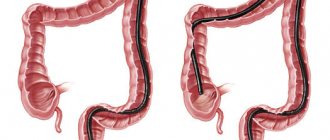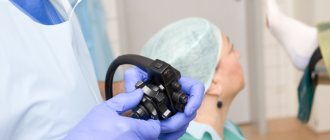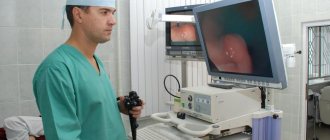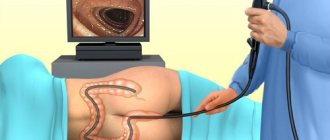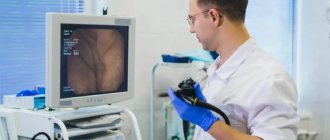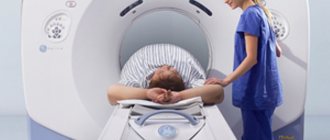ATTENTION! Starting from October 2021, a new medical center will open for you at the address: Dmitrovskoye Shosse, 81 (5 min. walk from the Selegerskaya metro station), where you can receive a wide range of medical services, including CT (computer tomography).
- home
- Proctology Center
- X-ray of the intestine
The large intestine is the final part of the digestive tract. In this section of the intestine, water is absorbed and feces are formed, which will then be excreted from the body. In addition, the large intestine is responsible for absorbing vitamins, amino acids, glucose, and electrolytes from food. This part of the digestive tract is susceptible to a variety of diseases - the appearance of tumors, inflammatory processes, impaired absorption of nutrients and peristalsis (motor and contractile activity of muscle tissue in the walls of the intestine, promoting the movement of its contents). Why are such pathologies dangerous? They directly affect the general condition of a person, and some of them (this is more true for oncology) are extremely dangerous to life and health if they are not identified in time and treatment is not started. One of the methods for diagnosing diseases of this part of the gastrointestinal tract is radiography of the large intestine.
X-ray of the large intestine: irrigoscopy and irrigography
X-ray examination of the intestines is widely used as a method of diagnosing its condition using X-rays. Since the organ examined in this way is hollow, the procedure is informative only with the use of a contrast agent.
Irrigoscopy and irrigography - these are the names of x-rays of the large intestine found in the medical literature. As for the differences between these categories, there are several points of view on this matter. One of them says that radiography of the large intestine can be correctly called both irrigoscopy and irrigography, that is, these are similar concepts without any differences.
According to another theory, irrigography involves recording the image obtained by X-ray irradiation on a special film, while irrigoscopy allows you to display the image on the monitor of a device for monitoring the large intestine in real time. There are no differences in terms of technique or methods of preparation.
Irrigoscopy itself can be of two types - it depends on the contrasting technique:
- classical irrigoscopy involves the introduction of a contrast agent in a liquid state;
- irrigoscopy with double contrast: in this case, the patient is first injected with liquid contrast that envelops the intestinal walls, after which gas or air is gradually introduced into the intestinal cavity.
Menu (Power Mode)
The menu before intestinal irrigoscopy is based on a list of permitted/prohibited foods and depends on the duration of the diet. Meals are fractional (4-6 times), in small portions. Below is a sample menu for a slag-free diet.
5-3 days before intestinal irrigoscopy
| Breakfast |
|
| Snack |
|
| Dinner |
|
| Dinner |
|
3-2 days before irrigoscopy
| Breakfast |
|
| Snack |
|
| Dinner |
|
| Dinner |
|
1 day before irrigoscopy
| Breakfast |
|
| Snack |
|
| Dinner |
|
| Dinner |
|
Indications and contraindications for irrigoscopy
The list of reasons why a doctor may send a patient for examination of the condition of the large intestine includes characteristic pathologies affecting this section of the gastrointestinal tract. Usually people see a doctor with typical symptoms:
- bowel dysfunction (disorder or constipation, if long-term);
- flatulence;
- bleeding from the anus;
- pain, a feeling of heaviness in the abdomen;
- the presence of blood in the stool.
However, the symptoms themselves are not grounds for prescribing irrigoscopy. The doctor conducts a survey and examination of the patient, directs him to undergo various tests, and issues a referral for an ultrasound of the abdominal organs. Having received all the results, the doctor then decides whether an X-ray of the large intestine with contrast is necessary.
The indication for prescribing a procedure, most often, is the suspicion of the presence of a certain illness or condition, if the results of preliminary tests and examinations do not allow an accurate diagnosis and determination of the etiology of the process. The doctor refers the patient to an x-ray, suspecting:
- the presence of tumors and polyps;
- gastric and intestinal bleeding with a tendency to recur;
- Crohn's disease;
- intestinal obstruction of any nature;
- diverticulitis;
- dolichosigma;
- Hirschsprung's disease (congenital anomaly);
- presence of foreign bodies;
- ulcerative, ischemic, pseudomembranous colitis;
- various inflammatory processes in the intestines.
Pain syndromes in the anus, anus, abdominal cavity, excessive organ mobility, prolonged and painful constipation, and systematic intestinal disorders are also indications for irrigography.
In what cases should a patient not undergo the procedure? Doctors list the following factors as contraindications to irrigography:
- rapidly progressing ulcerative colitis;
- presence of pregnancy;
- toxic megacolon;
- severe colitis;
- presence of allergies or intolerance to contrast agents;
- cardiovascular diseases, hypertension;
- early postoperative period, if the intervention took place in the abdominal cavity.
How to properly prepare for a colon x-ray
The procedure is practically not carried out without special preparation: its results in this case simply will not be of value, since, firstly, feces will remain in the intestines, distorting the picture, and secondly, the contrast agent will not be able to be fully distributed throughout the organ.
Therefore, before the procedure, the patient should take care of cleansing the large intestine.
Preparation includes compliance with dietary restrictions, mechanical and medicinal cleansing measures. Two to three days before the scheduled date of the x-ray, you are prohibited from consuming:
- raw vegetables: beets, carrots, cabbage;
- millet, pearl barley and oatmeal;
- apples;
- apricots;
- black bread;
- peas and other legumes;
- alcohol and carbonated drinks;
- fried or grilled foods.
On the eve of the procedure, before going to bed, you should take a laxative prescribed by the doctor. Before this, a cleansing enema is recommended. Be sure to do an enema on the morning of the procedure.
Authorized Products
The diet of a slag-free diet is allowed to include lean (vegetable) broths and non-concentrated soups based on chicken and beef meat, dietary meats (chicken, turkey, rabbit), low-fat varieties of white fish (pike, cod, perch, pike perch) boiled or steamed .
The diet may include chicken eggs, boiled soft-boiled or in the form of an omelet, butter, semolina and corn cereals, white rice, canned or boiled vegetables without seeds and peels (cucumbers, potatoes, carrots), unrefined vegetable oils, dairy products (yogurt without additives, low-fat cottage cheese, kefir, skim milk), mild cheese, premium wheat pasta, white bread crackers, diet cookies, fruit juice without pulp, compotes without grounds, still drinking water, jelly and compotes from dried fruits, honey, natural syrups and jellies, peaches, apricots, ripe melon, green and herbal tea.
Table of permitted products
| Proteins, g | Fats, g | Carbohydrates, g | Calories, kcal | |
Vegetables and greens | ||||
| canned eggplants | 0,9 | 0,7 | 7,3 | 49 |
| mashed potatoes | 2,5 | 4,2 | 14,7 | 106 |
| boiled carrots | 0,8 | 0,3 | 5,0 | 25 |
| canned cucumbers | 2,8 | 0,0 | 1,3 | 16 |
| boiled beets | 1,8 | 0,0 | 10,8 | 49 |
| canned tomatoes | 1,1 | 0,1 | 3,5 | 20 |
Fruits | ||||
| canned fruits | 0,5 | 0,1 | 9,5 | 40 |
| apricots | 0,9 | 0,1 | 10,8 | 41 |
| peaches | 0,9 | 0,1 | 11,3 | 46 |
Cereals and porridges | ||||
| buckwheat | 4,5 | 2,3 | 25,0 | 132 |
| semolina porridge on water | 2,5 | 0,2 | 16,8 | 80 |
| white boiled rice | 2,2 | 0,5 | 24,9 | 116 |
Flour and pasta | ||||
| premium pasta | 10,4 | 1,1 | 69,7 | 337 |
| noodles | 12,0 | 3,7 | 60,1 | 322 |
| spaghetti | 10,4 | 1,1 | 71,5 | 344 |
Bakery products | ||||
| white bread crackers | 11,2 | 1,4 | 72,2 | 331 |
Confectionery | ||||
| jelly | 2,7 | 0,0 | 17,9 | 79 |
| cracker cookies | 11,3 | 13,4 | 67,1 | 352 |
Raw materials and seasonings | ||||
| honey | 0,8 | 0,0 | 81,5 | 329 |
| sugar | 0,0 | 0,0 | 99,7 | 398 |
Dairy | ||||
| dairy products | 3,2 | 6,5 | 4,1 | 117 |
Cheeses and cottage cheese | ||||
| cheese | 24,1 | 29,5 | 0,3 | 363 |
| cottage cheese 0.6% (low fat) | 18,0 | 0,6 | 1,8 | 88 |
Meat products | ||||
| boiled beef | 25,8 | 16,8 | 0,0 | 254 |
| veal | 19,7 | 1,2 | 0,0 | 90 |
| rabbit | 21,0 | 8,0 | 0,0 | 156 |
Bird | ||||
| boiled chicken breast | 29,8 | 1,8 | 0,5 | 137 |
| boiled chicken fillet | 30,4 | 3,5 | 0,0 | 153 |
| boiled turkey fillet | 25,0 | 1,0 | — | 130 |
Eggs | ||||
| omelette | 9,6 | 15,4 | 1,9 | 184 |
| soft-boiled chicken eggs | 12,8 | 11,6 | 0,8 | 159 |
Fish and seafood | ||||
| boiled fish | 17,3 | 5,0 | 0,0 | 116 |
| zander | 19,2 | 0,7 | — | 84 |
| cod | 17,7 | 0,7 | — | 78 |
| pike | 18,4 | 0,8 | — | 82 |
Oils and fats | ||||
| vegetable oil | 0,0 | 99,0 | 0,0 | 899 |
| butter | 0,5 | 82,5 | 0,8 | 748 |
Non-alcoholic drinks | ||||
| green tea | 0,0 | 0,0 | 0,0 | — |
| hibiscus tea | 0,3 | 0,0 | 0,6 | 5 |
Juices and compotes | ||||
| apricot juice | 0,9 | 0,1 | 9,0 | 38 |
| jelly | 0,2 | 0,0 | 16,7 | 68 |
| Apple juice | 0,4 | 0,4 | 9,8 | 42 |
| * data is per 100 g of product | ||||
Irrigoscopy for adults and children: technique
The diagnostic procedure can only be carried out in a medical institution, in some cases with the patient admitted to a hospital. The doctor makes every effort to ensure that the examination is carried out as quickly and safely as possible for the patient.
Initially, the radiologist will need to take several survey images, with the patient alternately in a lying and standing position.
The patient lies on the couch in the left lateral position. A contrast agent is injected through the anus and rectum using a special contrast enema.
For this purpose, two types of contrasts are used in medicine:
- a preparation with barium, in which the main substance is barium sulfate, and the auxiliary substances are tannin, sodium citrate, gelatin or cellulose;
- sodium amidotrizoate - it is contained in more expensive drugs like Urografin or Verografin.
The second type of drugs is mainly used to examine newborns, or for patients of any age with suspected perforation of the intestinal wall.
The process itself is divided into several phases. The first of these is the weak filling phase, when the contrast gradually envelops all the folds of the mucous membrane, visualizing them well. This is followed by the tight filling phase - during it the intestine is completely filled with contrast, which makes it possible to evaluate the thickness of the lumen, shape, location, contours, the presence of foreign bodies, places of narrowing and expansion. Based on how quickly the contrast is eliminated by the intestines, the doctor can draw conclusions about the elasticity of the walls and intestinal motility.
During the process, the doctor will need about 500 milliliters of solution. If you are having a double contrast procedure, slightly less fluid will be needed. Gas or air is introduced into the cavity in order to give a clearer view of the thickness of the walls and folds of the mucous membrane, and to better visualize the organ. This phase is called the double contrast phase.
After administration of the substance, when the rectum and sigmoid colon are filled with contrast, the patient is placed on his back and then on his right side. The doctor takes a series of pictures at different phases of filling. Next, if necessary, the doctor carefully introduces air into the intestine and takes a few more pictures, this time with double contrast.
The patient now has a bowel movement. When all the contrast has left the organs, the doctor takes a final image of the abdominal cavity without contrast.
The mechanism for performing irrigoscopy for children is no different. For young patients, whenever possible, they try to prescribe alternative methods of examination, since preparation requires significant time and effort, and the procedure itself is not pleasant, although it is painless. Children of primary school age may undergo irrigography under general anesthesia.
When performing irrigography on a patient, the doctor may encounter some difficulties. If preparation is poor, there may be stool in the intestines, visible in the photographs. If the sphincter is weak, the patient will experience contrast incontinence. In addition, the contrast agent may be unevenly distributed throughout the large intestine, making it difficult to analyze the resulting images.
A danger for the patient is the situation when the pathologically altered intestinal wall is perforated due to the administration of contrast. In each specific case, the radiologist is responsible for deciding whether or not to carry out the procedure further. If necessary, the doctor stops the examination at any stage and begins providing emergency medical care to the subject.
Possible risks and consequences of the procedure
Doctors consider irrigography to be a safe type of examination for humans. Provided that all preparation requirements are met, and the doctor has a sufficient level of qualifications, the patient usually does not have any problems after an X-ray of the colon with contrast. However, there are exceptions, for example, when perforation of the affected intestinal wall occurs due to the administered contrast, or when the contrast agent enters the abdominal cavity.
In some cases, after diagnosis, the patient feels weakness, drowsiness and dizziness. Such symptoms are not dangerous and pass quickly.
If, after the procedure, the patient systematically notices an increase in body temperature, intestinal disorders, blood coming out of the anus, nausea, vomiting and abdominal pain, he should definitely visit his doctor.
Examination of the large intestine using barium preparations and X-ray irradiation is a reliable way to identify diverticulosis, rectal cancer, dolichosigma, the presence of foreign bodies, and other pathologies, diseases, and functional disorders. In addition to the fact that, thanks to the results of irrigoscopy, the doctor can make a primary or confirm an existing diagnosis, the procedure also allows you to determine the presence of grounds for surgical intervention.
Quitting the diet
After completion of irrigoscopy, a gradual gradual exit from the slag-free diet is required for approximately 5-7 days. If you violate the rules and quickly include fatty meat products and various root vegetables in your diet, there is a risk of constipation and the formation of fecal stones.
Expand your diet first with foods that are easily digestible in the body (vegetables, cereals, fruits), and if you feel normal, introduce fatty meats and previously prohibited foods on the 3rd-4th day. Continue to stay hydrated. After irrigoscopy, in order to normalize the intestinal biocenosis, it is recommended to take probiotics , which will also help improve digestion processes.
How does the human large intestine work, why is it examined?
The main stages of digestion associated with the primary processing and digestion of incoming food occur in the stomach and small intestine. However, after the food bolus passes into the large intestine, the process of its processing does not end - it is the large intestine that is responsible for the further entry of remaining beneficial substances into the blood from processed food.
Anatomically, the department is represented by the cecum, colon, sigmoid and rectum. The colon, in turn, has three subsections - ascending, transverse and descending. The rectum has a wider part - the so-called ampulla of the rectum, and a tapering section located closer to the anus - the anus. Visually, the large intestine looks like a loop, the shape of which is similar to a square with an open contour. On average, its diameter reaches 6-6.5 centimeters, and its length is about two meters.
The large intestine contains a wide range of different beneficial bacteria. Its special flora contributes to the further processing of the food bolus and its transformation into feces. What is useful that remains in the contents of the food bolus at the stage of its presence in the thick section is processed and converted by bacteria into vitamins, sugars and amino acids. They are then absorbed by the mucous walls of the intestine, from where the beneficial substances enter the blood.
Leftover food that can no longer be digested accumulates in the large intestine in order to leave the body during bowel movements.
The large intestine, as part of a well-functioning mechanism, performs its functions in conjunction with the rest of the digestive tract, so in the body of a healthy person, food passes a continuous path from the mouth to the rectum, through which the body leaves what is left of this food after processing.
What happens if pathological changes appear in the large intestine? The patient experiences characteristic symptoms, deterioration in health, weight loss, abdominal pain and other ailments. In such cases, it is necessary to prescribe diagnostic procedures, in particular, x-rays of the large intestine.
Fully or partially limited products
The diet of a slag-free diet provides for the complete exclusion of fatty meats and meat products (canned food, smoked sausages, bacon, ham), marinades, smoked meats, animal fats, all raw vegetables and root vegetables (radishes, cabbage, garlic, carrots, turnips, beets, onions), garden greens, coarse porridges (oatmeal, pearl barley, millet), fatty varieties of white and red fish, mushrooms, legumes (lentils, peas, beans, beans), which cause increased gas formation in the intestines, rye bread, fruits (grapes, pear, peach, bananas , tangerines, apple), dried fruits and all types of nuts and berries.
Whole milk and dairy products - cream, sour cream (with the exception of fermented milk) are excluded from the diet. It is not allowed to consume chocolate, any pastries and sweets, coffee, juices with pulp and nectars, confectionery products (cakes, cakes, cookies), sweets, carbonated drinks, seasonings. Drinking alcohol-containing and sweet carbonated drinks is strictly prohibited.
Table of prohibited products
| Proteins, g | Fats, g | Carbohydrates, g | Calories, kcal | |
Vegetables and greens | ||||
| beans | 6,0 | 0,1 | 8,5 | 57 |
| peas | 6,0 | 0,0 | 9,0 | 60 |
| Brussels sprouts | 4,8 | 0,0 | 8,0 | 43 |
| cauliflower | 2,5 | 0,3 | 5,4 | 30 |
| bulb onions | 1,4 | 0,0 | 10,4 | 41 |
| carrot | 1,3 | 0,1 | 6,9 | 32 |
| radish | 1,2 | 0,1 | 3,4 | 19 |
| white radish | 1,4 | 0,0 | 4,1 | 21 |
| turnip | 1,5 | 0,1 | 6,2 | 30 |
| beans | 7,8 | 0,5 | 21,5 | 123 |
| horseradish | 3,2 | 0,4 | 10,5 | 56 |
| garlic | 6,5 | 0,5 | 29,9 | 143 |
Fruits | ||||
| oranges | 0,9 | 0,2 | 8,1 | 36 |
| bananas | 1,5 | 0,2 | 21,8 | 95 |
| cherry | 0,8 | 0,5 | 11,3 | 52 |
| grapefruit | 0,7 | 0,2 | 6,5 | 29 |
| lemons | 0,9 | 0,1 | 3,0 | 16 |
| apples | 0,4 | 0,4 | 9,8 | 47 |
Berries | ||||
| grape | 0,6 | 0,2 | 16,8 | 65 |
Mushrooms | ||||
| mushrooms | 3,5 | 2,0 | 2,5 | 30 |
Nuts and dried fruits | ||||
| nuts | 15,0 | 40,0 | 20,0 | 500 |
| dried fruits | 2,3 | 0,6 | 68,2 | 286 |
| raisin | 2,9 | 0,6 | 66,0 | 264 |
Snacks | ||||
| potato chips | 5,5 | 30,0 | 53,0 | 520 |
| salted popcorn | 7,3 | 13,5 | 62,7 | 407 |
Cereals and porridges | ||||
| porridge with milk | 3,3 | 2,9 | 17,4 | 105 |
| oat bran | 8,0 | 4,0 | 10,0 | 110 |
| pearl barley porridge | 3,1 | 0,4 | 22,2 | 109 |
| millet porridge | 4,7 | 1,1 | 26,1 | 135 |
| boiled brown rice | 2,6 | 0,9 | 22,8 | 110 |
| barley porridge | 11,5 | 2,0 | 65,8 | 310 |
| rye bran | 11,2 | 3,2 | 32,0 | 221 |
Flour and pasta | ||||
| pancakes | 6,1 | 12,3 | 26,0 | 233 |
| vareniki | 7,6 | 2,3 | 18,7 | 155 |
| dumplings | 11,9 | 12,4 | 29,0 | 275 |
Bakery products | ||||
| loaf with wheat bran | 9,2 | 2,8 | 51,4 | 273 |
| buns | 7,9 | 9,4 | 55,5 | 339 |
| rye-wheat bread | 8,1 | 3,4 | 42,2 | 222 |
Confectionery | ||||
| candies | 4,3 | 19,8 | 67,5 | 453 |
| cake | 3,8 | 22,6 | 47,0 | 397 |
| halva | 11,6 | 29,7 | 54,0 | 523 |
Cakes | ||||
| cake | 4,4 | 23,4 | 45,2 | 407 |
Chocolate | ||||
| chocolate | 5,4 | 35,3 | 56,5 | 544 |
Raw materials and seasonings | ||||
| seasonings | 7,0 | 1,9 | 26,0 | 149 |
| mayonnaise | 2,4 | 67,0 | 3,9 | 627 |
Dairy | ||||
| milk | 3,2 | 3,6 | 4,8 | 64 |
| condensed milk | 7,2 | 8,5 | 56,0 | 320 |
Meat products | ||||
| pork | 16,0 | 21,6 | 0,0 | 259 |
| salo | 2,4 | 89,0 | 0,0 | 797 |
Sausages | ||||
| smoked sausage | 28,2 | 27,5 | 0,0 | 360 |
Bird | ||||
| duck | 16,5 | 61,2 | 0,0 | 346 |
| goose | 16,1 | 33,3 | 0,0 | 364 |
Fish and seafood | ||||
| pink salmon | 20,5 | 6,5 | 0,0 | 142 |
| Red caviar | 32,0 | 15,0 | 0,0 | 263 |
| salmon | 19,8 | 6,3 | 0,0 | 142 |
| seaweed | 0,8 | 5,1 | 0,0 | 49 |
| fish balyk | 20,4 | 12,5 | 0,0 | 194 |
| herring | 16,3 | 10,7 | — | 161 |
| salmon | 21,6 | 6,0 | — | 140 |
Oils and fats | ||||
| animal fat | 0,0 | 99,7 | 0,0 | 897 |
| cooking fat | 0,0 | 99,7 | 0,0 | 897 |
Alcoholic drinks | ||||
| dry white wine | 0,1 | 0,0 | 0,6 | 66 |
| red dessert wine | 0,5 | 0,0 | 20,0 | 172 |
| whiskey | 0,0 | 0,0 | 0,4 | 235 |
| vodka | 0,0 | 0,0 | 0,1 | 235 |
| cognac | 0,0 | 0,0 | 0,1 | 239 |
| liquor | 0,3 | 1,1 | 17,2 | 242 |
| beer | 0,3 | 0,0 | 4,6 | 42 |
Non-alcoholic drinks | ||||
| cola | 0,0 | 0,0 | 10,4 | 42 |
| sprite | 0,1 | 0,0 | 7,0 | 29 |
| tonic | 0,0 | 0,0 | 8,3 | 34 |
| Fanta | 0,0 | 0,0 | 11,7 | 48 |
| energy drink | 0,0 | 0,0 | 11,3 | 45 |
Juices and compotes | ||||
| grape juice | 0,3 | 0,0 | 14,0 | 54 |
| * data is per 100 g of product | ||||
What diseases can affect the large intestine?
Most often, patients with problems with the large intestine find:
- ulcerative colitis;
- colon cancer and polyps;
- Crohn's disease;
- ischemic and pseudomembranous colitis;
- irritable bowel syndrome;
- wall diverticula;
- congenital anomalies.
Ulcerative colitis
Pathology is a chronic condition of an organ when its internal mucous membrane becomes swollen, inflamed, changes its color from normal beige-pink to bright red, and loses its integrity due to small ulcerative formations. These ulcers do not heal well and bleed. If the disease lasts for a long time and without adequate treatment, it can provoke the appearance of polyps and neoplasms.
Oncology, polyps, neoplasms
Tumors in the large intestine are quite common in patients. Colon cancer is generally one of the four most common types of cancer on the planet. Polyps and tumors in this part of the body are most dangerous because their appearance is practically asymptomatic, and in the early stages they can only be detected by accident. The consequences of oncological and tumor processes in the colon can be the most severe, including death.
Crohn's disease
The disease is characterized by a general inflammatory process in the digestive tract, which also covers the large intestine, not only the inner lining of the walls, but also the middle and outer lining, as well as the lymphatic vessels located nearby. The disease is difficult to diagnose, its manifestations take the form of symptoms of a dozen other pathologies, and its complications are extraintestinal in nature - damage to large joints, the appearance of ulcers in the oral cavity, vision problems.
Ischemic and pseudomembranous colitis
In ischemic colitis, the degenerative process affects the vascular system that supplies the intestinal walls. Ischemia is characterized by local inflammation and ulceration of the mucous layer of the wall, and the gradual development of intestinal obstruction.
Pseudomembranous colitis develops due to a significant proliferation of one of the types of intestinal bacteria - clostridia. Typically, the intestinal flora carries out self-regulation - each type of bacteria controls the growth and development of all the others. With long-term use of antibiotics, laxatives or cytostatics, some bacterial species are destroyed, and, accordingly, others increase in proliferation.
Clostridia, in the process of their life activity, produce toxins that negatively affect the intestinal lining, which is why fibrinous plaques called pseudomembranes form on them.
Irritable bowel syndrome
The main cause of IBS is considered to be impaired intestinal motility, but the disease can also be secondary, that is, it can occur against the background of other diseases of the gastrointestinal tract. There is a constant feeling of discomfort in the intestines, the localization and symptoms of which are quite difficult to accurately determine.
Diverticula and diverticulitis
Diverticula in the walls of the large intestine look like pouches. In essence, they represent a stretching of the wall, which creates a “pocket” that protrudes towards the abdominal cavity. The process without complications can, in the worst case, cause constipation or a feeling of heaviness in the abdomen. However, if intestinal contents stagnate in the cavity, against the background of dysbiosis in the intestines, diverticulitis can develop - acute inflammation with characteristic symptoms that are dangerous for humans.
Congenital structural defects
Such disorders include elongation of the sigmoid colon (dolichosigma), as well as hypertrophy of the colon in any of the departments, or in a specific segment. Pathologies are characterized by disorders of intestinal processes, constipation, and flatulence. In severe cases, intoxication may occur with feces that cannot leave the body in time.

